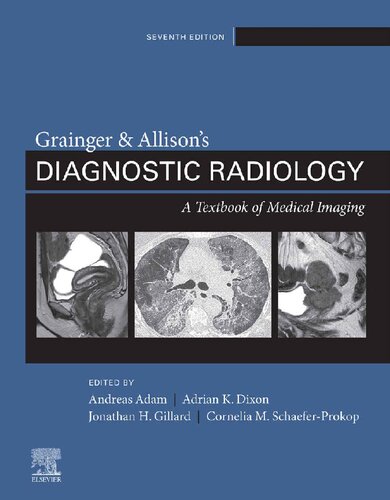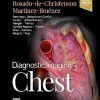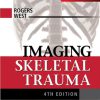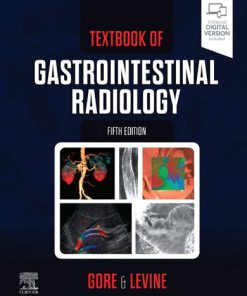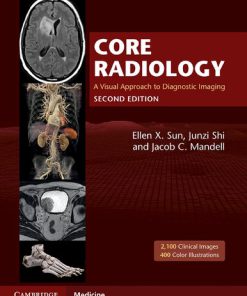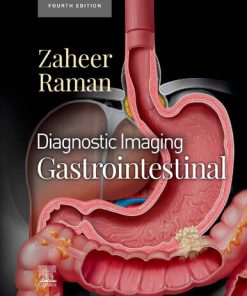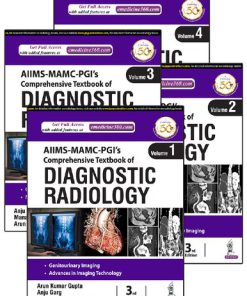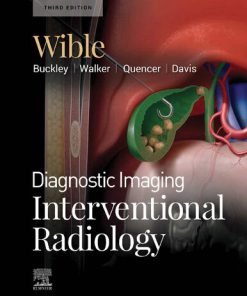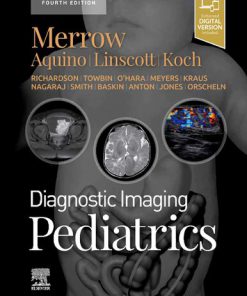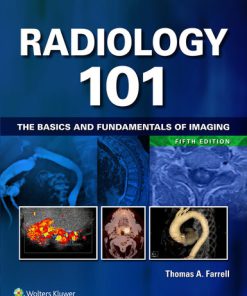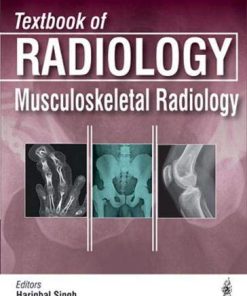Grainger & Allison’s Diagnostic Radiology. A Textbook of Medical Imaging 7th Edition by Andreas 9780702075612 0702075612
$50.00 Original price was: $50.00.$25.00Current price is: $25.00.
Grainger & Allison’s Diagnostic Radiology. A Textbook of Medical Imaging 7th Edition Andreas Adam – Ebook Instant Download/Delivery ISBN(s): 9780702075612, 0702075612
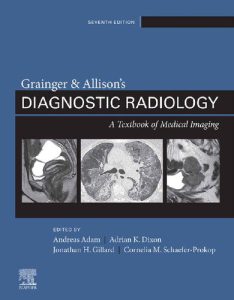
Product details:
- ISBN 10:0702075612
- ISBN 13:9780702075612
- Author: Andreas
Grainger & Allison’s Diagnostic Radiology
Table contents:
Table of Contents
Copyright
Contents
Preface
List of Section Editors
List of Contributors
Dedication
Section A: The Chest and Cardiovascular System
1: Current Status of Thoracic Imaging
Abstract
Chest Radiography
Computed Tomography of the Thorax
Ultrasound
Magnetic Resonance Imaging
Radionuclide Imaging
2: The Normal Chest
Abstract
The Lungs
The Central Airways
The Lungs Beyond the Hila
The Hila
The Mediastinum
The Diaphragm
3: The Chest Wall, Pleura, Diaphragm and Intervention
Abstract
The Chest Wall
The Pleura
Diaphragm
4: The Mediastinum, Including the Pericardium
Abstract
Mediastinal Diseases
Pericardium
Acknowledgement
5: Pulmonary Infection in Adults
Abstract
Types of Pneumonias
Clinical Utility and Limitations of Chest Radiography and Computed Tomography
Patterns of Pulmonary Infection
Complications of Pneumonia
Integrating Clinical and Imaging Findings
Changing Spectrum of Human Immunodeficiency Virus Infections: 40 Years Later
Parasitic Infections
6: Large Airway Disease and Chronic Airflow Obstruction
Abstract
Introduction
Tracheal Disorders
Bronchiectasis
Broncholithiasis
Obliterative (Constrictive) Bronchiolitis
Chronic Obstructive Pulmonary Disease
Asthma
7: Pulmonary Lobar Collapse: Essential Considerations
Abstract
Mechanisms and Causes of Lobar Collapse
Radiographic Considerations
Computed Tomography of Lobar Collapse
Other Imaging Techniques in Lobar Collapse
Patterns of Lobar Collapse
8: Pulmonary Neoplasms
Abstract
Histopathology
Pulmonary Sarcoma and Other Primary Malignant Neoplasms
Benign Pulmonary Tumours
Benign Lymphoproliferative Disorders
Malignant Lymphoproliferative Disorders
Metastases
9: High-Resolution Computed Tomography of Interstitial and Occupational Lung Disease
Abstract
High-Resolution Computed Tomography Patterns of Diffuse Lung Disease
Idiopathic Interstitial Pneumonias
Sarcoidosis
Hypersensitivity Pneumonitis
Langerhans Cell Histiocytosis
Lymphangioleiomyomatosis
Connective Tissue Diseases
Systemic Vasculitides
Drug-Induced Lung Disease
Occupational Lung Disease
10: Thoracic Trauma and Related Topics
Abstract
Thoracic Trauma
Thoracic Imaging in the Intensive Care Patient
Post-Surgical Imaging in the Chest
11: Airspace Diseases
Abstract
Introduction
Suggested Approach to the Radiological Diagnosis of Airspace Diseases
Pulmonary Oedema
Diffuse Pulmonary Haemorrhage
Organising Pneumonia
Pulmonary Alveolar Proteinosis
Alveolar Microlithiasis
12: Cardiac Anatomy and Imaging Techniques
Abstract
Normal Chest Radiography
Cardiac Magnetic Resonance
Computed Tomography Imaging Techniques
Echocardiography
Acknowledgement
13: Congenital Heart Disease: General Principles and Imaging
Abstract
Specific Lesions
Conclusion
14: Nonischaemic Acquired Heart Disease
Abstract
Role of Imaging
Cardiomyopathies
Valvular Heart Disease
Tumours of the Heart
Malignant Cardiac Tumours
Pericardial Diseases
15: Ischaemic Heart Disease
Abstract
Introduction
Pathophysiology of Ischaemic Heart Disease
Coronary Artery Imaging
Functional Imaging
Stress Imaging
Myocardial Infarct Imaging
Myocardial Viability Imaging
Imaging of Complications Related to Ischaemic Heart Disease
Prognosis Assessment in Ischaemic Heart Disease
Role of Conventional Chest Radiography in Ischaemic Heart Disease
Differential Diagnosis in Ischaemic Heart Disease
16: Pulmonary Circulation and Pulmonary Thromboembolism
Abstract
Pulmonary Circulation
Pulmonary Thomboembolic Disease
Conclusion
Acknowledgements
17: The Thoracic Aorta: Diagnostic Aspects
Abstract
The Normal Aorta
Diagnostic Aspects
Acquired Aortic Abnormalities
Congenital Aortic Abnormalities
Section B: Abdominal Imaging
18: Current Status of Imaging of the Gastrointestinal Tract
Abstract
Plain Abdominal Radiograph and Interpretation
Abnormal Gas Distribution
Dilatation of Bowel
Abnormal Bowel Wall Pattern
Acute Abdominal Inflammatory Conditions
Imaging the Abdomen With Computed Tomography: Radiation Issues
Automatic Tube Current Modulation
Iterative Reconstruction Algorithms
Role of MRI in the Acute Abdomen
Radiation Dose Reduction in Clinical Practice
19: The Oesophagus
Abstract
Anatomy and Function
Examination
Pathological Features
20: The Stomach
Abstract
Anatomy
Radiological Techniques
Cross-Sectional Imaging
Gastric Pathology
Neoplastic Diseases
Miscellaneous Conditions
The Postoperative Stomach
Advances in Gastric Imaging
21: The Small Intestine, Mesentery and Peritoneal Cavity
Abstract
The Duodenum
Disorders of the Duodenum
The Small Intestine
Disorders of the Small Intestine
The Peritoneal Cavity, Mesentry and Omentum
Neoplastic Diseases
22: The Large Bowel
Anatomy
Radiological Investigation
Tumours
Diverticulitis
Epiploic Appendagitis
Colitis
Other Common Causes of Colitis
Miscellaneous Conditions
Functional Disorders of the Anorectum
Anal Fistula
23: The Liver and Spleen
Abstract
Liver
Liver Imaging Techniques
Diffuse Disease
Spleen
24: The Biliary System
Abstract
Biliary Anatomy
Methods of Investigation
Disorders of the Gallbladder
Role of Radiology in Investigation of Jaundice
Benign Bile Duct Pathology
Neoplastic Bile Duct Pathology
Interventional Techniques
25: The Pancreas
Abstract
Embryology
The Normal Pancreas
Congenital Anomalies
Pancreatitis
Acute Pancreatitis
Chronic Pancreatitis
Pancreatic Neoplasms
Multisystem Diseases With Involvement of the Pancreas
Trauma
Pancreatic Transplant Imaging
Interventional Radiology
26: Common Uroradiological Referrals: Haematuria, Loin Pain, Renal Failure and Infection
Abstract
Haematuria
Loin Pain
Renal Failure
Infection
27: Current Status of Imaging of the Urinary Tract: Imaging Techniques, Overview of Anatomy and Radiation Issues
Abstract
Introduction
Anatomy of the Urinary Tract
Techniques
Radiation Issues
Conclusion
28: Benign Upper Urinary Tract Conditions: Congenital Anomalies, Cysts, Calculi, Nephrocalcinosis
Abstract
Congenital Anomalies
Cysts
Calculi
Nephrocalcinosis
29: Renal Masses: Imaging and Biopsy
Abstract
Methods of Analysis
Benign Renal Masses
Neoplastic Renal Masses
30: Renal Transplantation: Imaging
Abstract
History of Transplantation
Surgical Technique
Radiological Techniques
Vascular Complications: Early
Vascular Complications: Intermediate to Late
Nephrogenic Complications
Renal Transplant Biopsy
Use of Isotope Studies and Renal Transplant
Radiological Evaluation of Potential Donor Kidneys
31: Urothelial Cell Cancer, Upper Tract and Lower Tract
Abstract
Upper Tract Urothelial Carcinoma
Conclusions and Summary
Bladder Cancer
32: Prostate
Abstract
Introduction
Anatomy
Risk Stratification
Detection and Localisation
Prostate Imaging—Reporting and Data System
Magnetic Resonance Sequences
Benign Findings
Staging
Nodal Staging
Non-Nodal Metastases
Local Disease Stage
Post-Treatment Evaluation
Prostate Biopsy
33: The Male Reproductive Structures
Abstract
Scrotal Masses
Male Infertility
34: Gynaecological Imaging in Oncology
Abstract
Imaging Techniques
Endometrial Carcinoma
Carcinoma of the Cervix
Ovarian Carcinoma
Conclusion
Acknowledgements
35: Benign Gynaecological Disease
Abstract
Imaging Techniques
Congenital Anomalies of the Female Genital Tract
Benign Uterine Conditions
Pelvic Pain
Benign Ovarian Conditions
Vaginal Cysts
Pelvic Floor Dysfunction
Infertility and Pregnancy-Related Imaging
36: Genitourinary Tract Trauma
Abstract
Introduction
Renal Trauma
Ureteral Injury
Bladder Injury
Urethral Injury
Scrotal Injury
Penile Injuries
37: Adrenal Imaging
Abstract
The Adrenal Glands
Conclusion
Section C: The Musculoskeletal System
38: Current Status of Imaging of The Musculoskeletal System
Abstract
Introduction
Conventional Radiography
Ultrasound
Computed Tomography
Magnetic Resonance Imaging
Nuclear Medicine
Arthrography
39: Internal Derangements of Joints: Upper and Lower Limbs
Abstract
Introduction
The Shoulder
The Acromioclavicular Joint
The Sternoclavicular Joint
The Elbow
Hand and Wrist
The Hip
The Knee
The Ankle and Foot
40: Bone Tumours (1): Radiological Approach, Benign Tumours and Tumour-Like Lesions of Bone
Abstract
General Characteristics of Bone Tumours
Benign Bone Tumours
41: Bone Tumours (2): Radiological Approach, Malignant Bone Tumours
Abstract
Introduction
Bone Metastases
Primary Malignant Neoplasms of Bone
42: Soft-Tissue Tumours
Abstract
World Health Organisation Classification of Soft-Tissue Tumours
Acknowledgement
43: Metabolic and Endocrine Skeletal Disease
Abstract
Bone Physiology and Pathophysiology
Osteoporosis
Parathyroid Disorders
Rickets and Osteomalacia
Sclerosing Bone Diseases and Other Bone Disorders
Miscellaneous
44: Arthritis
Abstract
Imaging of Joint Disease
Osteoarthritis
The Inflammatory Arthritides
45: Appendicular and Pelvic Trauma
Abstract
Introduction
Fracture Types
The Shoulder
Acromio-Clavicular Joint
The Elbow
The Wrist
Pelvic and Acetabular Fractures
The Knee
The Ankle
Foot Injuries
46: Bone, Joint and Spinal Infections
Abstract
Introduction
Epidemiology
Classification
Paediatric Musculoskeletal Infections
Adult Musculoskeletal Infections
Diabetic Foot
Septic Arthritis
Musculoskeletal Tuberculosis
Unusual Musculoskeletal Infections
Differential Diagnosis
Management
Spinal Infection
Section D: The Spine
47: Current Status of Imaging of the Spine and Anatomical Features
Abstract
Anatomy
Imaging Techniques
48: Degenerative Disease of the Spine
Abstract
Introduction
Degenerative Disc Disease
Pathology of the Posterior Elements
Degenerative Spinal Stenosis
Degenerative Scoliosis
49: Spinal Tumours
Abstract
Radiological Investigations in Spinal Tumours
Classification of Spinal Tumours
50: Non-Tumoural Spinal Cord Lesions
Abstract
Inflammatory Disease
Demyelinating Polyneuropathies
Vascular Diseases
Developmental and Cyst-Like Lesions
Neurodegenerative and Metabolic Diseases
51: Postoperative Spine
Abstract
Introduction
Principles of Spinal Surgery
Imaging Techniques in Postoperative Spine
Intraoperative and Perioperative Complications
Early Complications
Late Complications
52: Spinal Trauma
Abstract
Imaging Techniques and Evaluation
Specific Injury Patterns
Section E: Neuroimaging
53: Current Status of Imaging of the Brain and Anatomical Features
Abstract
Introduction
Anatomy of the Brain and Vascular System
Brain Anatomy
Cerebral Vasculature
Techniques for Imaging the Brain and Cerebral Vasculature
54: Imaging of Head Trauma
Abstract
Introduction
Modality and Technique
Mechanism of Injury
Primary Injury
55: Benign and Malignant Intracranial Tumours in Adults
Abstract
Radiological Investigations in Intracranial Tumours
Intra-Axial Tumours
Extra-Axial Tumours
56: Neurovascular Diseases
Abstract
Non-Traumatic Intracranial Haemorrhage
57: Intracranial Infections
Abstract
Bacterial Infections
Fungal Infections
Viral Infections
Parasitic Infections
58: Inflammatory and Metabolic Disease
Abstract
Inflammatory-Demyelinating Disorders of the Central Nervous System
Primary and Secondary Vasculitis
Neurosarcoidosis
Behçet Disease
Systemic Lupus Erythematosus
Metabolic and Toxic Disorders in the Adult
Drug-Induced Encephalopathies
Other Intoxications
Metabolic Encephalopathy
Acknowledgements
59: Neurodegenerative Diseases and Epilepsy
Abstract
Ageing and Dementia—Introduction and Clinical Overview
Normal Ageing Phenomena in the Brain
Dementia—Imaging Approach
Alzheimer Disease and Other Primary Neurodegenerative Dementias
Vascular Dementia
Rapidly Progressive and Other Atypical Dementias
Parkinson Disease and Related Disorders
Epilepsy
Epilepsy—Imaging Approach
60: The Orbit
Abstract
The Retro-Orbital Visual Pathway
61: Head and Neck Radiology
Abstract
Introduction
The Ear
The Sinonasal Region
The Oral Cavity
The Salivary Glands
Fractures of the Facial Skeleton
The Temporomandibular Joint
The Suprahyoid Neck
The Infrahyoid Neck
Cervical lymph nodes
Acknowledgements
Section F: Oncological Imaging
62: Introduction to Oncological Imaging
Abstract
Imaging Techniques for Cancer Imaging
Diagnosis and Imaging
Staging
Assessment of Treatment Response
Surveillance and Restaging
Conclusion
63: The Breast
Abstract
Mammographic Techniques
Ultrasound
Normal Breast Anatomy
Breast Pathology
Breast Magnetic Resonance Imaging
Nuclear Medicine Techniques
Interventional Breast Radiology
Breast Cancer Screening Programmes
Conclusion
64: Reticuloendothelial Disorders: Lymphoma
Abstract
Epidemiology
Histopathological Classification
Staging, Investigation and Management
Lymph Node Disease in Lymphoma
Extranodal Disease in Lymphoma
Lymphoma in the Immunocompromised
Monitoring Response to Therapy
Surveillance and Detection of Relapse
Conclusion
65: Bone Marrow Disorders: Haematological Neoplasms
Abstract
Myeloproliferative Neoplasms
Haematologic Malignancies
Lymphoma
Plasma Cell Dyscrasias
Miscellaneous Conditions
66: Bone Marrow Disorders: Non-Neoplastic Conditions
Abstract
Disorders of Red Cells
The Myelodysplastic Syndromes
The Haemoglobinopathies
Disorders of Blood Coagulation
67: Imaging for Radiotherapy Planning
Abstract
Types of Radiotherapy
The Radiotherapy Pathway
Image-Guided Radiotherapy
Functional Imaging in the Radiotherapy Process
Radiomics
Conclusion
68: Functional and Molecular Imaging for Personalized Medicine in Oncology
Abstract
Personalised Medicine in Oncology
Dynamic Contrast Enhanced-Computed Tomography
Magnetic Resonance Imaging
Positron Emission Tomography
Emerging Molecular Imaging Techniques and Theranostics
Conclusion: Role of Functional and Molecular Imaging in Oncology
Section G: Paediatric Imaging
69: Current Status of Paediatric Imaging
Abstract
Projection Radiography
Fluoroscopy
Ultrasound
Computed Tomography
Magnetic Resonance Imaging
Nuclear Medicine
70: The Neonatal and Paediatric Chest
Abstract
The Neonatal Chest
The Chest in Older Children
New techniques in paediatric respiratory imaging
71: Paediatric Abdominal Imaging
Abstract
Introduction
The Infant and Older Child
The Immunocompromised Child
Abdominal Manifestations of Cystic Fibrosis
Abdominal Trauma
The Liver
Biliary System
Pancreas
Spleen
72: Imaging of the Kidneys, Urinary Tract and Pelvis in Children
Abstract
Congenital Anomalies
Antenatal Diagnosis of Pelvicalyceal and/or Ureteral Distention
Renal Cystic Disease
Renal Calculi
Tumours
Hypertension
Trauma
Renal Transplantation
73: Skeletal Radiology in Children: Non-Traumatic and Non-Malignant
Abstract
Constitutional Disorders of Bone
Localised Disorders of the Skeleton
Neurocutaneous Syndromes
Inflammatory Disorders
Non-Inflammatory Disorders
Metabolic and Endocrine Disorders
Haemoglobinopathies
Storage Disorders
Infection of the Bones and Joints
Acknowledgements
74: Paediatric Musculoskeletal Trauma and the Radiology of Nonaccidental Injury and Paediatric Factures
Abstract
Physeal Injuries
The Upper Limb
The Lower Limb
Cervical Spinal Injuries
Nonaccidental Injury
Clinical Presentation and the Role of the Radiologist
Injury Patterns
General Imaging Strategies
Skeletal Injury
Brain Injuries
75: Bone Tumours and Neuroblastoma in Children
Abstract
Bone Tumours
Neuroblastoma
76: Paediatric Neuroradiology
Abstract
Normal Brain Maturation
Brain Malformations and Developmental Abnormalities
Neurocutaneous Syndromes
Spinal Malformations
Inborn Metabolic Brain Disorders
Craniosynostosis
Neonatal Nasal Obstruction: Nasal Cavity Stenosis/Atresia
Brain Tumours
Cerebrovascular Disease and Stroke
Hypoxic Ischaemic Injury in the Developing Brain
Miscellaneous Acquired Toxic or Metabolic Disease
Intracranial and Intraspinal Infections
Trauma
Hydrocephalus
Summary
Section H: Interventional Radiology
77: Current Status of Imaging for Interventional Procedures
Abstract
Introduction
Computed Tomography Angiography in Clinical Practice
Dual-Energy Computed Tomography Angiography
Magnetic Resonance Angiography in Clinical Practice
Computed Tomography Angiography or Magnetic Resonance Angiography: Safety, Preference and Ease of Use
Imaging in Specific Conditions
Renovascular Hypertension
Assessment of the Mesenteric Vasculature: Acute and Chronic Mesenteric Ischaemia and Acute Gastrointestinal Bleeding
Computed Tomography Angiography for Acute Gastrointestinal Bleeding
Computed Tomography Angiography and Magnetic Resonance Angiography for Pulmonary Embolism
Other Pulmonary Conditions
Diagnosis of Stroke: Computed Tomography and Magnetic Resonance
Diagnosis of Acute Arterial Wall Dissection
Elucidating the Source of Embolic Stroke
Subclavian Steal Syndrome
Peripheral Vascular Disease
Computed Tomography Angiography
Magnetic Resonance Angiography
Computed Tomography and Magnetic Resonance for Planning of Percutaneous Biopsy, Abscess Drainage and Tumour Ablation
78: Angiography: Principles, Techniques and Complications
Abstract
Introduction
Angiographic Technique
Equipment
Closure Devices
Contrast Medium
Complications of Angiography
79: Aortic Intervention
Abstract
Introduction
Perioperative Management Including Infrastructure and Staffing
Stent-Grafts and Basic Principles of Stent-Grafting
Thoracic Aortic Intervention
Acute Aortic Syndrome
Traumatic Lesions of the Thoracic Aorta
Abdominal Aortic Intervention
Surveillance Imaging and Complications
Endoleak
Device Migration, Dislocation, Kinking and Occlusion
Graft Infection (See Fig. 79.33)
Summary and Conclusion
80: Peripheral Vascular Disease Intervention
Abstract
Arterial System
Venous System
81: Image-Guided Biopsy and Ablation Techniques
Abstract
Image-Guided Biopsy
Image-Guided Tumour Ablation
82: Image-Guided Drainage Techniques
Abstract
Indications and Contraindications
Imaging Guidance
Patient Preparation and Care
Catheter Insertion
Catheter Management
Specific Drainage Techniques
Conclusion
83: Hepatobiliary Intervention
Abstract
Vascular Interventional Techniques in the Liver
84: Vascular Genitourinary Tract Intervention
Abstract
Kidney
Trauma Embolisation (Table 84.4)
Prostatic Artery Embolisation
Fibroid Embolisation
Obstetric Haemorrhage
Pelvic Congestion Syndrome
Varicocele
85: Non-Vascular Genitourinary Tract Intervention
Abstract
Introduction
Percutaneous Renal Access—Important Anatomical Factors
General Equipment for Renal Access
Percutaneous Nephrostomy (PCN)
Percutaneous Nephrolithotomy (PCNL)
Antegrade Ureteric Stents
Monitoring Ureteric Stents
Balloon Dilatation of Ureteric Strictures
Treatment of Urinary Leaks and Fistulas
Suprapubic Bladder Catherisation
Managing a Non-Deflatable Urinary Catheter Balloon
Percutaneous Cystolithotripsy (PCCL)
Interventional Procedures in the Prostate Gland and Seminal Vesicles
Ablation of Renal Cysts or Lymphoceles
86: Venous Access and Interventions
Abstract
Introduction
Prior General Assessment
General Patient and Interventional Suite Preparation
Central Venous Catheters
Complications and Their Management
Diagnostic Evaluation
87: Skeletal Interventions
Abstract
Introduction
Image-Guided Bone Biopsy
Spinal Infiltration Procedures
Radiofrequency for Pain Management
Percutaneous Discectomy
Percutaneous Vertebral Augmentation
Osteoplasty and Osteosynthesis
Ablation of Bone Tumours
Embolisation of Bone Tumours
Neuromodulation and Neurostimulation
Index
People also search:
grainger & allison’s diagnostic radiology
grainger & allison’s diagnostic radiology a textbook of medical imaging
grainger diagnostic clinic
grainger and allison’s diagnostic radiology
grainger and allison’s diagnostic radiology pdf
You may also like…
Medicine - Radiology
Textbook of Gastrointestinal Radiology 5th Edition Richard M. Gore
Medicine - Radiology
Core Radiology A Visual Approach to Diagnostic Imaging 2nd Edition Ellen X. Sun
Medicine - Others
Medicine - Cardiology
Medicine - Radiology
Comprehensive Textbook of Diagnostic Radiology Third Edition. Edition Manavjit Singh Sandhu
Medicine - Radiology
Medicine - Radiology
Radiology 101 The Basics and Fundamentals of Imaging 5th Edition Thomas A. Farrell
Medicine - Radiology
Textbook of Radiology Musculoskeletal Radiology 1st Edition Hariqbal Singh M.D.

